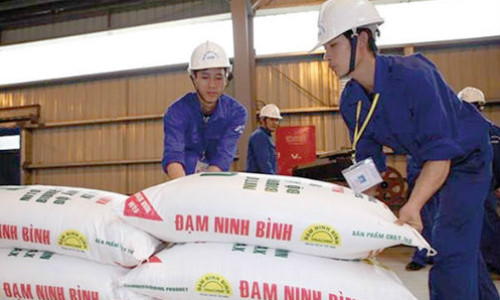Vinachem turns to government for aid
 |
| Vinachem is struggling to repay the $250 million loan to China Eximbank |
| RELATED CONTENTS: | |
| Former oil and gas officials: the path from high posts to prison | |
| Imported DAP fetiliser products under investigation | |
| Why Government sticks to equitization | |
In the report submitted to the prime minister on June 28, the Ministry of Finance (MoF) revealed that in 2016, the total assets of Ninh Binh Nitronegous Fertiliser Plant was VND10.075 trillion ($443.3 million), a reduction of 8.65 per cent compared to 2015, although the plant had stable operations with positive production and consumption figures.
In 2016, Vinachem helped Ninh Binh plant paying off $25 million in matured debts for China Eximbank.
“The declining profit in 2016 derived from decreasing revenues and fertiliser selling prices, so revenues could not cover expenses. Totally, in 2016, the Ninh Binh fertiliser plant suffered a loss of VND1.132 trillion ($49.8 million). Also, it has no appropriate business plan to reduce production costs in this difficult period,” MoF said.
Up till now, the Ninh Binh plant has suffered huge accumulated losses. According to newswire VnEconomy, its loss was VND75 billion ($3.3 million) in 2012, over VND759 billion ($33.4 million) in 2013, over VND500 billion ($22 million) in 2014, and over VND592 billion ($26 million) in 2015. Its accumulated losses at present amounted to over VND3.058 billion ($134.6 million).
Regarding Vinachem, MoF’s report indicated that the group’s total assets decreased by 1.68 per cent in 2016. Vinachem reported a loss of VND895 billion ($39.4 million) because its cost of goods sold and interest expenses increased, while revenues and income decreased.
“Vinachem’s profitability indicators were negative in 2016, which means that its business was not efficient and it needs adjustments and a better business plan. Its financial pressures in the coming period will be high because Vinachem still contributes capital to 40 enterprises,” the report indicated.
To deal with the huge amount of debts and losses, Vinachem proposed to focus on paying off arising interests and expenses for Bank of Investment and Development of Vietnam. Vinachem’s report expressed its expectation to pay off the entire principal by the end of 2028.
The Ninh Binh plant is located in the northern province of Ninh Binh. It has an annual capacity of 560,000 tonnes, with the total investment of about $667 million. This is Vinachem’s biggest wholly-owned project. However, Vinachem’s actual investment in this project was $100 million only, as it had to borrow an additional $250 million from China Eximbank at the annual preferential interest rate of 4 per cent.
The plant was officially put into operation in 2012, but since then it has been continuously suffering losses.
In the report submitted to the prime minister, MoF said that Vinachem’s loan of $250 million from China Eximbank had a term of 15 years. As of March 31, 2017, the loan balance was $162.5 million.
What the stars mean:
★ Poor ★ ★ Promising ★★★ Good ★★★★ Very good ★★★★★ Exceptional
Latest News
More News
- 14th National Party Congress expected to shape Vietnam’s path to 2045 (January 17, 2026 | 16:00)
- CVFA chief highlights role of 14th National Party Congress (January 17, 2026 | 15:54)
- Tablets to replace paper at 14th Party Congress (January 16, 2026 | 21:27)
- Hanoi to display firework to celebrate the 14th National Party Congress (January 16, 2026 | 21:21)
- Vietnam, UN strengthen cooperation in digital technology, AI (January 16, 2026 | 16:48)
- VN-Index could reach 2,040 points in 2026 (January 16, 2026 | 16:41)
- Consumer deals drive Vietnam’s M&A rebound in December (January 16, 2026 | 16:08)
- ASML signals long-term commitment to Vietnam (January 16, 2026 | 12:00)
- Ho Chi Minh City starts construction of four key infrastructure projects (January 15, 2026 | 17:22)
- ASEAN Digital Ministers' Meeting opens in Hanoi (January 15, 2026 | 15:33)















 Mobile Version
Mobile Version